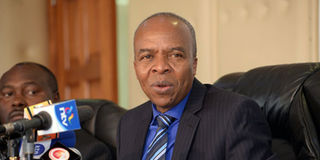Premium
Roads in Nairobi set for expansion to unlock traffic

Former Cabinet Secretary for Transport and Infrastructure Michael Kamau.
What you need to know:
Once internal road expansion networks are complete, a major project — the Mass Rapid Transit System (MRTS) that comprises the rail and road network — will commence.
A memorandum of understanding signed last Tuesday by governors of five neighbouring counties gave the go-ahead on the MRTS that would decongest Nairobi and its environs.
Nairobi, Kiambu, Murang’a, Machakos and Kajiado leaders signed the memorandum at a forum convened by Transport and Infrastructure Cabinet Secretary Michael Kamau.
Five roads in Nairobi are set for a major makeover as the government receives bids for design and construction of the 167-km road and rail transport grid.
A statement by the Ministry of Transport last week said plans are underway to expand roads in Nairobi to ease congestion. These comprise 53km Jomo Kenyatta International Airport (JKIA) Rironi Road, Juja Road, Jogoo Road, Outer Ring Road and Ngong Road — which will be developed to form the Bus Rapid Transit System..
Nairobi Governor Evans Kidero confirmed that the procurement process is on for 70 high capacity buses that will operate in Nairobi after construction of internal routes is complete, paving the way for the Bus Rapid Transit System.
The buses will be shipped from Berlin, with the help of German firm Gauffe Ingenieure.
An update on the project shows that the Ministry of Transport and Infrastructure has completed work on the design for the bus rapid transit system (BRT) for JKIA-Rironi Road. The World Bank has also set aside funds for a BRT design for Juja Road.
Transport principal secretary Nduva Muli said African Development Bank has released funds for work to commence on Jogoo Road. A detailed design is ongoing.
“Outering Road will be expanded and a bus rapid transit system considered while Ngong Road will be transformed into a four-lane dual carriage way with financing from Japan International Cooperation Agency,” said Mr Muli.
A plan by the Kenya National Highways Authority (Kenha) shows that the bus rapid transit route will feature a single carriageway running in the middle section of the highway from JKIA to Kikuyu.
Internal road expansion
Once internal road expansion networks are complete, a major project — the Mass Rapid Transit System (MRTS) that comprises the rail and road network — will commence.
A memorandum of understanding signed last Tuesday by governors of five neighbouring counties gave the go-ahead on the MRTS that would decongest Nairobi and its environs.
Nairobi, Kiambu, Murang’a, Machakos and Kajiado leaders signed the memorandum at a forum convened by Transport and Infrastructure Cabinet Secretary Michael Kamau.
This gives way for construction of the Sh89 billion MRTS, which is a road and rail transport grid expected to link the city to key neighbouring towns and municipalities such as Kikuyu, Kitengela, Machakos, Limuru, Thika, Ruiru, Athi River and Kajiado.
According to a plan by the Transport ministry, Phase 1 of the project starts in 2017 and ends by 2030. It prioritises the bus transit system network. The rail system will be dictated by the bus transit routes.
Mr Kidero disclosed that work on the BRT would begin next month.
Phase 2 will begin after 2030 and will entail the actual process of constructing the lanes using the laid down network.
Under the plan shared by the ministry last week, the current Nairobi Railway Station area, including the yards, will accommodate a 24-storey central hub terminal for the MRTS. All railway lines will originate and traverse at this point.
The blueprint also shows that the complete road networks will be serviced by a closed rapid bus system, complete with special feeder services. The bus routes will run alongside the normal highways.
“About 400 buses will operate within the routes when phase one is complete,” Transport Cabinet Secretary Michael Kamau said.
The rail transport platform is to accommodate 76 stations and five maintenance depots to service passenger needs.
The World Bank, in conjunction with the government, conducted a study in 2011 on the transport situation in Nairobi. The study showed that high traffic in the capital city translates into billions of shillings lost annually (the cost of wasted hours and fuel).
The traffic state is considered chronic; this has attracted donor interest in the MRTS project with both World Bank and European Union showing massive support.
World Bank already released Sh27 billion as the project kicked off in 2012. European Union on the other hand said last week Thursday that it will contribute Sh7 billion towards the project.
Mr Erik Habers, Head of Development at the EU in Kenya said in a statement that the money will be spread over a period of four years, “The European Union has already supported developing the capital’s public transport infrastructure with research and reports into issues of demand, costs, and different options for mass transit, engineering





